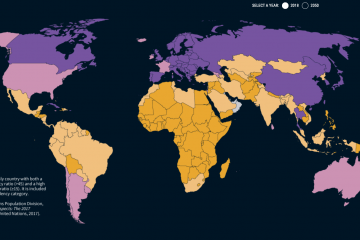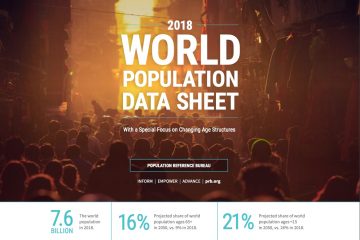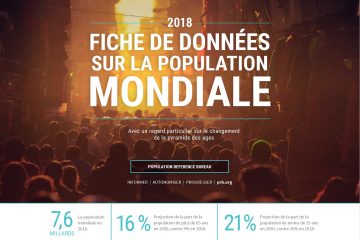
PRB Projects 2.3 Billion More People Living on Earth by 2050
The world population will reach 9.9 billion by 2050, up 2.3 billion or 29 percent from an estimated 7.6 billion people now, according to projections by Population Reference Bureau (PRB) included in the 2018 World Population Data Sheet.
PRB estimates the 2018 worldwide total fertility rate (TFR, or average births per woman over their lifetime) at 2.4; the global TFR has been declining for the past few decades but remains high enough to generate continued population growth. The three countries with the highest TFRs are Niger (7.2), Chad (6.4), and the Democratic Republic of the Congo (6.3), while the lowest TFRs are in South Korea (1.1), Singapore (1.2), and Taiwan (1.2).
PRB projects Africa’s population will more than double to 2.6 billion by 2050 and account for 58 percent of the global population increase by that date. The number of people in Asia is projected to rise about 717 million to 5.3 billion, while Europe (which includes all of Russia) would see a decline in population from 746 million to 730 million. The Americas population is projected to increase from 1 billion now to 1.2 billion, and Oceania (which includes Australia and New Zealand) is seen rising from 41 million to 64 million.
PRB has produced its widely referenced World Population Data Sheet annually since 1962. This year’s edition provides the latest data on 26 key population, health, and environment indicators for the world, major regions, and more than 200 countries and territories.
Below are some highlights from PRB’s midcentury population projections in the 2018 World Population Data Sheet:
- The population of 26 countries, nearly all in Africa, will at least double. Niger in West Africa will see its population nearly triple.
- A total of 38 countries will have smaller populations in 2050 than in 2018. China will register the largest numerical population decrease―about 50 million―followed by Japan at 25 million and Russia at 9.4 million. Romania will see the largest percentage decline in population (23 percent).
- The population of the United States will reach 390 million, up from 328 million in 2018.
- China’s population will decrease by about 50 million from its current size to 1.34 billion. India will supplant China as the world’s most populous country with 1.68 billion people.
- Nigeria will become the third most populous country as its population rises to 411 million, up 109 percent from 2018. Nigeria is currently the seventh most populous country.
Changing Age Structures and Their Implications
The world population will also continue to age, with variations by country. By midcentury, projections indicate that 16 percent of the world population will be ages 65 and older, up from 9 percent now. The percentage of people in this age bracket in the world’s more-developed countries is projected to reach 27 percent, up from 18 percent now, while the percentage of adults ages 65 an older in less-developed countries is projected to double to 14 percent.
The 2018 Data Sheet’s special focus is on changing age structures around the world. Shifts in a country’s age structure over time can have important implications for a country’s economic and social trajectory, as well as its resource allocations and policy agendas. For example, many countries in the world are experiencing—and will continue to experience—steady increases in the number of older adults, both in absolute terms and as a percentage of the total population. This trend poses challenges for countries in balancing the pension, health, and other benefits that older adults typically receive with investments in the well-being of younger generations. In addition, some countries may choose to incentivize older adults to remain in the work force longer.
As part of the analyses for this Data Sheet, PRB demographers grouped countries into five age dependency categories to better illustrate their demographic challenges and opportunities. The categories were based on two factors: the child dependency ratio—the ratio of children (those under age 15) to the working-age population (ages 15 to 64); and the old-age dependency ratio—the ratio of older adults (ages 65 and older) to the working-age population.
Interactive maps on worldpopdata.org display countries’ estimated age dependency categories for 2018 and projected age dependency categories for 2050.
The age structure data and analysis show that:
- By 2050, 82 countries are projected to have at least 20 percent of their population ages 65 and over, up from 13 countries today.
- The population ages 65 and older in Northern Africa is projected to nearly quadruple by 2050.
- The percentage of the population ages 65 and older in the United States is projected to increase from 15 percent in 2018 to 22 percent in 2050. The percentage of the U.S. population under age 15 is projected to decrease from 19 percent in 2018 to 17 percent by 2050.
- In Japan, more than one-third (36 percent) of the population is projected to be ages 65 and older by 2050, up from 28 percent now.
Download key charts and figures from our Social Media Toolkit.
Email PRB for more information about the 2018 World Population Data Sheet:
datasheet@prb.org.





